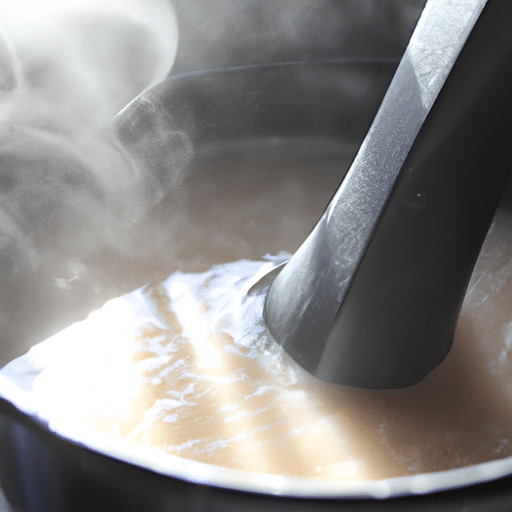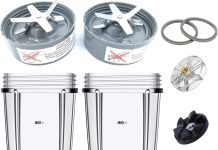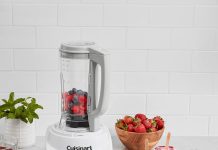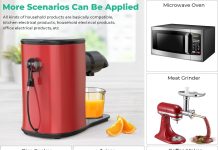If you’ve ever found yourself yearning for a steaming bowl of homemade soup or a rich and velvety sauce, then you’ve probably wondered if your regular blender can handle blending hot liquids. Well, fear not, because today we’re here to answer that burning question for you. Can you blend hot liquids in a regular blender? The answer may surprise you, so let’s dive right in and find out!
Review contents
Understanding Blenders
Blenders are versatile kitchen appliances that are designed to blend, puree, and mix various ingredients together. They consist of a motorized base that powers a sharp rotating blade to create a whirlpool effect, effectively breaking down the ingredients into a smooth and consistent texture. Blenders are commonly used for making smoothies, milkshakes, and sauces, but they can also handle hot liquids with the right precautions.
Definition of a Blender
A blender is a motorized kitchen appliance that is specifically designed to blend, mix, or puree ingredients into a smooth and consistent texture. It consists of a motorized base, a container or pitcher with a blade assembly, and controls to adjust the speed and power of the blender. Blenders come in various sizes and capacities, making it easy to find the perfect one for your needs.
Types of Blenders
There are several types of blenders available on the market, each with its own unique features and functionalities. The most common types of blenders include conventional blenders, high-performance blenders, and immersion blenders.
Conventional blenders are the traditional countertop blenders that are designed for basic blending tasks. They typically have a pitcher-style container and a removable lid with a spout for pouring. Conventional blenders are suitable for blending a wide range of ingredients, but they may have limitations when it comes to handling hot liquids.
High-performance blenders, on the other hand, are more powerful and capable of handling tougher ingredients. They often come with larger containers and stronger motors, allowing them to blend hot liquids more effectively. High-performance blenders are often used by professional chefs and avid home cooks who require a blender that can handle a variety of tasks.
Immersion blenders, also known as stick blenders or hand blenders, are handheld devices with a blending attachment at the end. They are versatile and convenient, perfect for blending hot liquids directly in the pot or container they are being cooked in. Immersion blenders are popular for making soups, sauces, and other hot liquid recipes.
Features of Blenders
Blenders come with a variety of features that can enhance their performance and usability. Some common features to look for when choosing a blender include variable speed settings, pulse function, pre-programmed settings, and different blade options.
Variable speed settings allow you to control the speed of the blades, giving you more control over the texture of your blend. Pulse function, on the other hand, provides short bursts of power for quick and precise blending. Pre-programmed settings are convenient options that automatically adjust the speed and power based on the type of food being blended.
Different blade options, such as a multipurpose blade or a specialized ice-crushing blade, can make a difference in how well the blender performs various blending tasks. It’s important to consider the types of recipes you’ll be making and choose a blender that has blades suitable for your needs.
Hot Liquids and Blenders
While blenders are primarily used for blending cold ingredients, they can also handle hot liquids under certain conditions. However, it’s important to understand the effects of heat on blenders, the risks associated with blending hot liquids, and the factors to consider to ensure safe and effective blending.
Effects of Heat on Blenders
Heat can have a significant impact on the performance and durability of blenders. Excessive heat can cause the motor to overheat, leading to reduced blending power and potentially damaging the blender. The heat can also affect the plastic components of the blender, causing them to warp or melt.
Additionally, extreme temperature changes can create pressure buildup inside the blender, which can cause the container or lid to burst, resulting in hot liquid splattering everywhere. This can pose a serious risk of burns and injuries. It’s essential to be aware of these effects and take appropriate precautions when blending hot liquids.
Risk of Blending Hot Liquids
Blending hot liquids without taking proper precautions can be dangerous. The pressure buildup caused by the heat can potentially cause the blender container to burst, resulting in hot liquid splattering and causing burns. The steam generated by the hot liquid can also create a risky situation, as it can cause the blender lid to pop off or the contents to overflow.
In addition to the risks of pressure buildup and steam, hot liquids can also cause a burning sensation if they come into contact with your skin while blending. It’s crucial to handle hot liquids with care and follow safety measures to prevent accidents and injuries.
Factors to Consider
Before blending hot liquids, it’s important to consider several factors to ensure safe and effective blending.
Firstly, it’s crucial to choose a blender that is capable of handling hot liquids. Not all blenders are designed for this purpose, and using the wrong blender can lead to accidents or damage to the appliance. Look for blenders that explicitly mention their ability to handle hot liquids or have a temperature resistance specification.
Secondly, consider the temperature of the liquid you intend to blend. Extremely hot liquids can pose a higher risk, so it’s advisable to let them cool down slightly before blending. This will reduce the pressure buildup and minimize the risk of accidents.
Lastly, always follow the manufacturer’s instructions and safety recommendations. Different blenders may have specific guidelines for blending hot liquids, such as leaving the lid slightly ajar to allow steam to escape or blending in short bursts to reduce pressure buildup. Always read the instructions carefully and follow them to ensure safe and successful blending.
Blending Process and Hot Liquids
The blending process and the temperature of the hot liquids can significantly impact the outcome and safety of blending. Understanding the blending components, ideal blending temperatures, and safety measures can help ensure a successful and secure blending experience.
Blending Components
The components involved in blending hot liquids include the blender motor, the container or pitcher, the lid, and the blades. Each component plays a crucial role in the blending process and can be affected by the heat.
The blender motor powers the rotating blades, allowing them to break down the ingredients into a smooth texture. Excessive heat can cause the motor to overheat and potentially reduce its performance or damage it. Be mindful of the motor’s temperature and avoid prolonged blending sessions with hot liquids.
The container or pitcher is where the ingredients and liquid are placed for blending. It’s essential to choose a container that is heat-resistant and can withstand the temperature of the hot liquid. Glass containers are often a safer choice for hot liquids, as they are less prone to warping or melting. However, some high-quality plastic containers may also be suitable for blending hot liquids.
The lid of the blender is another critical component to consider when blending hot liquids. The steam generated by the heat can create pressure buildup inside the blender, which can cause the lid to pop off or the contents to overflow. Some blenders have safety features, such as vented lids or release valves, to prevent this pressure buildup and ensure safe venting of steam.
The blades of the blender are responsible for breaking down the ingredients into a smooth texture. When blending hot liquids, it’s important to choose blades that are suitable for this purpose. Look for blades that are sturdy, durable, and resistant to heat. Stainless steel blades are often a good choice, as they can withstand high temperatures and maintain their sharpness.
Ideal Blending Temperatures
The ideal blending temperature for hot liquids can vary depending on the recipe and the capabilities of the blender. However, as a general guideline, it’s advisable to let the hot liquid cool down slightly before blending.
Blending extremely hot liquids can increase the risk of pressure buildup and splattering. By allowing the liquid to cool down for a few minutes, you reduce the chances of accidents and ensure safer blending. Aim for a temperature that is still hot enough to achieve the desired outcome but not so hot that it poses a significant risk.
Additionally, when blending ingredients that contain fats or oils, such as soups or sauces, it’s important to consider the melting points of these substances. Blending them at high temperatures can cause them to splatter or interact with the heat differently, potentially affecting the texture and consistency of the blend.
Safety Measures
To ensure safe blending of hot liquids, it’s essential to follow specific safety measures.
Firstly, select a blender that is specifically designed to handle hot liquids. Look for blenders that have a temperature resistance specification or explicit instructions for blending hot liquids.
Secondly, let the hot liquid cool down slightly before blending. This reduces the risk of pressure buildup and minimizes the chances of accidents. Use a food thermometer to check the temperature and ensure it is within a safe range.
Thirdly, follow the manufacturer’s instructions for blending hot liquids. Different blenders may have specific guidelines, such as leaving the lid slightly ajar to vent steam or blending in short bursts to avoid pressure buildup. Always read the instructions carefully and follow them to ensure safe blending.
Lastly, use caution when handling the blender and the hot liquid. Lift the lid carefully and keep your hands and face away from the blender during and after blending. Protect your skin from potential splatters by wearing oven mitts or using a towel to cover the lid while blending.
By following these safety measures, you can enjoy the convenience of blending hot liquids without compromising your safety.
Blender Types and Hot Liquids
Different types of blenders have varying capabilities when it comes to handling hot liquids. Understanding the limitations of conventional blenders, the benefits of high-performance blenders, and the convenience of immersion blenders can help you choose the right blender for your needs.
Conventional Blender Limitations
Conventional blenders, while versatile and capable of blending a wide range of ingredients, may have limitations when it comes to blending hot liquids. The plastic components of conventional blenders can be sensitive to extreme heat, warping, or melting under high temperatures.
Furthermore, the pressure buildup caused by blending hot liquids in a conventional blender can pose a risk of splattering or causing the lid to pop off. The blades of conventional blenders may also struggle with tougher ingredients or require longer blending times for hot liquids.
High-Performance Blender
High-performance blenders are designed to handle more demanding tasks, including blending hot liquids. These blenders come with larger containers, more powerful motors, and sturdier materials that can withstand the heat and pressure associated with hot liquid blending.
High-performance blenders often feature blades that are specifically designed to handle hot liquids, ensuring efficient blending and consistent results. They can easily break down tough ingredients and achieve smooth textures without the risk of overheating or damaging the blender.
If you frequently blend hot liquids or require a blender with more power and capabilities, investing in a high-performance blender may be a worthwhile option.
Immersion Blender
Immersion blenders, also known as stick blenders or hand blenders, are handheld devices that offer the convenience of blending hot liquids directly in the pot or container they are being cooked in. These blenders feature a motorized handle with a blending attachment at the end, making it easy to immerse them directly into the hot liquid.
Immersion blenders are suitable for blending soups, sauces, and other hot liquid recipes. They eliminate the need to transfer hot liquids to a conventional blender, reducing the risk of accidents and making the blending process more efficient.
When choosing an immersion blender for blending hot liquids, look for models with heat-resistant materials, durable blades, and controls that are easy to handle and operate.
Choosing the Right Blender
When it comes to blending hot liquids, choosing the right blender is crucial for safety and optimal results. Consider the following factors when selecting a blender for blending hot liquids.
Heat Resistance
Ensure that the blender you choose is specifically designed to handle hot liquids. Look for blenders with temperature resistance specifications, or choose models that explicitly mention their capability to blend hot liquids. Heat-resistant materials, such as glass containers or high-quality plastic, are preferable for hot liquid blending.
Motor Power
A blender with a powerful motor will be more effective in blending hot liquids. The motor power determines the speed and strength at which the blades rotate, ensuring efficient blending without overheating or strain. Look for blenders with higher wattage or horsepower for better performance.
Blending Capacity
Consider the capacity of the blender and choose a size that suits your needs. If you frequently blend large quantities of hot liquids, opting for a blender with a larger container will be more convenient. However, if you primarily blend smaller portions, a compact blender may be sufficient.
Stability
Ensure that the blender you choose is stable and can withstand the pressure buildup and vibrations associated with blending hot liquids. Look for blenders with a sturdy base and nonslip feet to prevent accidents and ensure secure blending.
By considering these factors, you can choose a blender that is suitable for blending hot liquids and enjoy the convenience of a safe and efficient blending experience.
Tips for Blending Hot Liquids
Blending hot liquids requires some extra care and attention to ensure safety and satisfactory results. Follow these tips for a successful blending experience with hot liquids.
Preparation
Before blending hot liquids, it’s important to prepare the ingredients and the blender properly. Cut the ingredients into smaller pieces to facilitate blending, ensuring that they are evenly distributed in the blender container.
Ensure that the blender container is clean and dry before adding the hot liquid. Any leftover residue or moisture can affect the blending process and potentially compromise the taste and texture of the final blend.
Cooling Down
To reduce the risk of accidents and pressure buildup, allow the hot liquid to cool down slightly before blending. This will minimize the chances of steam formation and reduce the strain on the blender’s components.
Use a food thermometer to measure the temperature of the liquid and ensure it is within a safe range. Aim for a temperature that is hot enough to achieve the desired outcome but not so hot that it poses a significant risk.
Blending Techniques
When blending hot liquids, it’s important to follow specific blending techniques to ensure safety and achieve the desired texture. Start with a low speed setting to gradually break down the ingredients and prevent splattering. Once the ingredients are partially blended, gradually increase the speed to achieve a smoother texture.
If the blender starts to struggle or shows signs of overheating, pause the blending process and allow the blender to cool down before continuing. Blending in short bursts can help reduce the strain on the blender and minimize the chances of overheating.
Venting Steam
The steam generated by hot liquids can cause pressure buildup inside the blender, posing a risk of accidents. To prevent this, some blenders have vented lids or release valves that allow the steam to escape during blending. If your blender has these features, ensure that they are functioning properly and use them to safely vent the steam.
If your blender does not have vented lids or release valves, it’s advisable to leave the lid slightly ajar to allow steam to escape. However, exercise caution as this may increase the risk of splatters. Alternatively, you can blend the hot liquid in shorter bursts, pausing to vent the steam between each blending session.
By following these tips, you can blend hot liquids safely and achieve the desired texture and consistency in your recipes.
Blending Alternatives
In situations where blending hot liquids may not be feasible or convenient, there are alternative kitchen appliances that can handle similar tasks. Consider the following alternatives if you are unable to blend hot liquids or prefer different methods of preparation.
Food Processor
A food processor is a versatile kitchen appliance that can handle a variety of tasks, including blending and pureeing ingredients. While it may not achieve the same level of smoothness as a blender, it can effectively process hot liquids into a chunky or semi-smooth texture.
Food processors typically come with sharp blades and multiple attachments, making them suitable for tasks like chopping, slicing, and grating. If you don’t have access to a blender or prefer a different texture for your hot liquid recipes, a food processor can be a viable alternative.
Hand Mixer
A hand mixer, also known as a hand-held electric beater, is a compact and versatile appliance that can handle various mixing and blending tasks. While it may not have the same power or blending capabilities as a blender, it can effectively blend hot liquids into a smoother texture.
Hand mixers typically come with detachable beaters or whisk attachments and variable speed settings. They are particularly useful for blending hot liquids directly in the pot or container they are being cooked in.
Stick Blender
A stick blender, also known as an immersion blender or hand blender, is a handheld device designed for blending, pureeing, and mixing ingredients directly in the pot or container they are being cooked in. This makes them a convenient and efficient alternative for blending hot liquids.
Stick blenders consist of a motorized handle with a blending attachment at the end. They are easy to operate, portable, and less bulky than traditional blenders or food processors. Stick blenders are particularly suitable for recipes that require blending hot liquids, such as soups, sauces, and gravies.
Recipes Suitable for Blending
Blending hot liquids opens up a world of culinary possibilities. From hearty soups and creamy purees to savory sauces and comforting hot drinks, there are countless recipes that can benefit from the smooth and consistent texture achieved through blending.
Soups and Purees
Soups and purees are perfect candidates for blending hot liquids. Whether it’s a classic tomato soup or a vibrant vegetable puree, blending hot liquids can create a smooth and velvety texture that enhances the overall taste and presentation.
Blending hot liquids allows you to incorporate the flavors and seasonings evenly, resulting in a consistent and well-balanced dish. It also helps to break down any fibrous or tough ingredients, ensuring a pleasant texture that is easy to digest.
Sauces and Gravies
Blending hot liquids can also be beneficial when making sauces and gravies. Whether it’s a rich marinara sauce or a luscious gravy for your roast, blending hot liquids can help achieve a smooth and silky consistency.
Blending sauces and gravies helps to emulsify the ingredients, resulting in a cohesive and well-incorporated sauce. It can also help to thicken the sauce or gravy, creating a more luxurious texture that coats the ingredients evenly.
Hot Drinks
Blending hot liquids can be a game-changer when it comes to hot drinks. From frothy lattes and indulgent hot chocolates to immune-boosting smoothies and bulletproof coffee, blending hot liquids can create a satisfying texture and enhance the overall drinking experience.
Blending hot drinks helps to combine the flavors and ingredients, creating a harmonious blend that is visually appealing and enjoyable to drink. It can also help to incorporate any powders or supplements, ensuring even distribution and optimal taste.
Common Issues and Troubleshooting
While blending hot liquids can be a convenient and efficient way to achieve smooth textures, there may be occasional issues that arise. Understanding common problems and troubleshooting techniques can help you overcome challenges and ensure successful blending.
Blender Overheating
Blenders can overheat when continuously used or when blending hot liquids for an extended period. Overheating can lead to reduced blending power, damage to the motor, or even cause the blender to shut off completely.
If your blender starts to overheat, it’s important to turn it off and give it time to cool down. Avoid restarting the blender immediately, as this will only prolong the overheating issue. Once the blender has cooled down, you can resume blending in shorter bursts to prevent overheating.
Additionally, ensure that the blender’s air vents are not blocked, as this can contribute to overheating. Keep the vents clean and free from any obstructions to ensure proper airflow and prevent excessive heat buildup.
Leaking
Leaking can occur when blending hot liquids due to the pressure buildup or a faulty seal between the blender container and the base. Leaking can result in a mess and may affect the overall blending process.
To prevent leaking, ensure that the blender container is securely attached to the base and that the lid is properly sealed. Check for any cracks or damage in the container or lid that may be contributing to the leakage. If leakage persists, it may be necessary to replace the container or lid to ensure a proper seal.
Burning Smell
A burning smell while blending hot liquids can indicate an issue with the blender, such as an overheating motor or a malfunctioning component. It’s important to address this issue promptly to prevent any further damage to the blender.
If you notice a burning smell, immediately turn off the blender and unplug it from the power source. Allow the blender to cool down completely before inspecting it for any visible signs of damage or burning. If the issue persists, it may be necessary to contact the manufacturer or a professional for further assessment and repair.
Subpar Blending Results
Sometimes, despite following all the necessary precautions and techniques, the blending results may not meet your expectations. The texture may be uneven, or the ingredients may not be adequately incorporated.
In such cases, first ensure that the blender container is the appropriate size for the quantity of ingredients being blended. Overloading the blender can affect the blending quality and result in subpar results.
Next, check the sharpness and condition of the blender blades. Dull or damaged blades may struggle to blend the ingredients effectively, resulting in uneven textures. If necessary, consider sharpening or replacing the blades to improve blending performance.
Lastly, assess the blending technique and duration. Ensure that you are using the appropriate speed settings and blending in short bursts if necessary. Adjusting the speed and blending duration can help achieve a more consistent and desirable texture.
Conclusion
Blending hot liquids safely and effectively requires an understanding of the capabilities and limitations of blenders, as well as the necessary precautions for handling heat and pressure buildup. By choosing the right blender, following proper techniques, and considering alternative appliances, you can enjoy the convenience and benefits of blending hot liquids in your culinary endeavors. Remember to prioritize safety, follow manufacturer guidelines, and indulge in the endless possibilities that blending hot liquids can offer in creating delicious and satisfying recipes.































